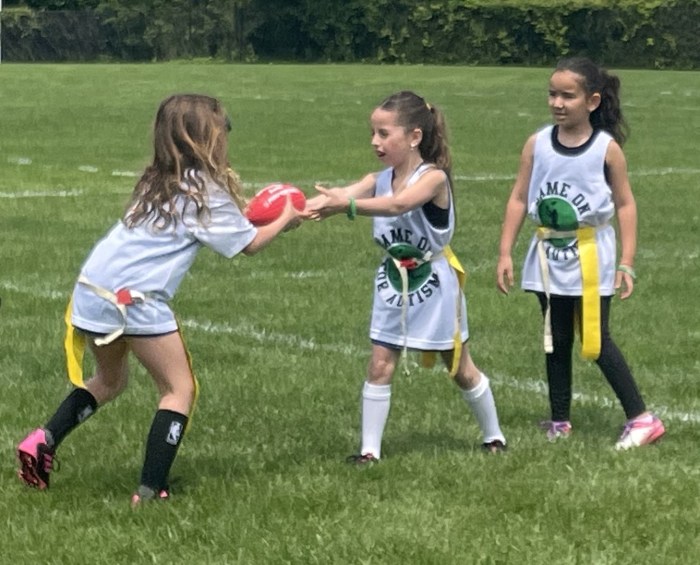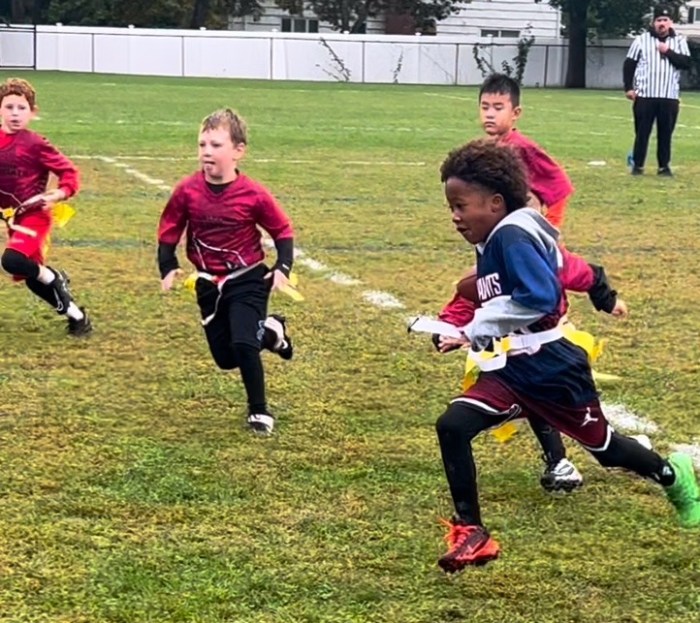It’s a sunny Saturday morning in Seaford. On the field, there are 14 players lined up opposite each other. The ball is snapped to the running back, who fakes left to the outside before tossing the football back to the quarterback – a flea flicker.
The quarterback uncorks a deep ball, targeting a receiver just short of the end zone. There’s traffic, and the wideout falls down as they fail to secure the ball. The player gets up, dusts themself off, and runs back to the huddle.
This type of scene has played itself out across generations of American youth athletes, but with one notable difference in this case: these players are all fourth-grade girls.
Flag football, once considered a safer alternative to tackle football, has exploded into one of the fastest-growing youth sports in the country – especially for girls. In New York and on Long Island, that surge has reshaped school programs and weekend leagues, giving girls the opportunity to participate in a national pastime typically reserved for boys.
“I’ve heard from parents that have said that their daughter really didn’t have a sport that she was interested in, started playing flag football, and that has become her whole existence,” said Robert Zayas, the executive director of the New York Public High School Athletic Association.
By the Numbers
New York added girls’ flag football as a championship sport in 2024, following a national trend that has seen high school participation in the sport rise an average of almost 60 percent year over year since 2022.
So far, 17 states offer fully sanctioned girls high school flag football, with 21 others running pilot programs for the sport, according to the NFL.
At the next level, the NCAA said that 65 colleges across the United States have either varsity or club women’s flag football. This includes traditional college football powers like Georgia, Florida, and Penn State.
“Now a lot of the SEC schools are offering scholarships,” said George Higgins, the founder of Long Island Flag Football League. “You got a pretty fair shot at that if you work on your game.”
Flag football will be an Olympic sport for both men and women at the 2028 Los Angeles Games. In anticipation of this, the NFL recently announced the creation of professional leagues set to start play by 2027.
The National Federation of State High School Associations, the governing body for high school sports in the United States, has data dating back to the 2018-2019 school year on girls’ flag football, which had just over 11,000 participants nationwide.
As of this spring, that number was almost 70,000 athletes. For reference, field hockey, a more established girls’ sport, reached a peak of around 50,000 participants nationwide during the 2024-2025 school year.
In New York, there has been a similar level of growth. There are five times as many girls playing high school flag football as there were in 2021, according to NFHS data. A little over five thousand girls played flag football in New York schools in the spring, just under a third of what soccer, the state’s most popular girls high school sport, drew.
The sport is also growing at the middle and elementary school levels.
Andrew Leahy, the head referee and league coordinator for Nassau County’s HTB&G Flag Football Sports League, said that they added their first girls’ team in 2021. That team had to play boys teams in their first season, but now there is a separate girls’ division.
“When we started, it was less than 1 percent girls enrolled,” Leahy said. “We are now at 20 percent girls’ teams in the league.”
Higgins said that girls’ flag football started to grow in popularity around 2018, when the NFL began showing more interest in promoting the sport.
“It’s really blown up,” said Higgins. “We have 7,000 kids playing on Long Island, and about 3,000 of [them] are girls.”
No Experience Needed
Flag football’s explosive growth can be in part attributed to one factor: approachability.
For many kids, the process of playing a high school sport begins in middle or even elementary school.
Zayas said that club sports have been increasing in popularity in recent years, leading to kids specializing earlier and showing up in high school with developed skillsets– and pushing those without that experience off of prep rosters.
“If you look at a freshman in high school playing girls’ lacrosse or softball, if you weren’t playing from a younger age, you probably may feel like you’re behind on a high school team,” he said.
“With flag football, I think it gives more kids the chance to participate who haven’t had the experience of participating for a number of years prior to high school.”
Higgins echoed this point, bringing up New York’s most popular girls’ sport as an example.
“Soccer is so competitive, and a lot of girls get shut out because you have travel teams, they have trainers, it’s super competitive,” he said. “Flag football, pretty much you try out, you’re on the team.”
Of course, this will not last forever as the sport continues to grow in popularity. In fact, there are emerging signs of a more specialized flag football ecosystem.
“That is something that I already see happening,” said Leahy. “There are winter [and] summer clinics that I see going on.”
Scheming it Up
Calling flag football “approachable” in its current form does not mean it is simpler than its tackle counterpart.
Much is often made about how tackle football is a game of scheme as much as it is physicality. Minus the contact, the same holds true for flag football.
This translates to the other side of the ball, too, where they can throw different defensive looks at opponents as needed.
This type of complex scheming is not limited to the high school level.
“Beyond the Gridiron
Outside of trick plays, touchdowns, and general physical activity, flag football has led to good things off the field.
“I’ve heard from student-athletes about what a positive impact it’s had upon their life, and it’s led to better grades and them wanting to be engaged in their school,” Zayas said.
Andrew Alexy, the coach of HTB&G’s Mercy Mavericks, said that the girls he coaches have learned the value of teamwork, adding that they put team success over that of the individual.
“After almost every game, they’re either having play dates, having pizza parties, doing pool parties,” he said. “They just love doing this together.”
Mackenzie Denker, a fourth-grader, echoed this, adding that she hopes to continue playing flag football in college.
“Football is my favorite sport,” she said, “and I like my team a lot.”
Alexy’s daughter, 9-year-old Rory, is definitely a fan also.
“It’s my favorite sport,” she said. “So, I’m probably gonna play it for a really long time.”



































